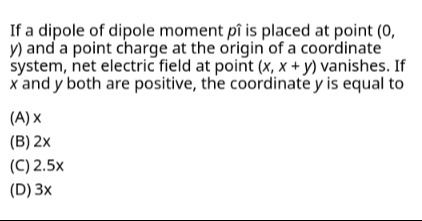Question
Question: If a dipole of dipole moment $p\hat{i}$ is placed at point (0, y) and a point charge at the origin o...
If a dipole of dipole moment pi^ is placed at point (0, y) and a point charge at the origin of a coordinate system, net electric field at point (x, x + y) vanishes. If x and y both are positive, the coordinate y is equal to

x
2x
2.5x
3x
2x
Solution
The problem requires us to find the relationship between x and y such that the net electric field at point P(x, x+y) is zero, given a point charge at the origin and a dipole at (0, y).
1. Electric Field due to the Point Charge (Q) at the Origin (0, 0): Let the point charge be Q. The position vector of point P(x, x+y) from the origin is rQ=xi^+(x+y)j^. The magnitude of this vector is rQ=x2+(x+y)2. The electric field due to the point charge Q at P is: EQ=4πϵ01rQ3QrQ=K(x2+(x+y)2)3/2Q(xi^+(x+y)j^) where K=4πϵ01.
2. Electric Field due to the Dipole (p=pi^) at (0, y): The dipole is located at (0, y). The position vector of point P(x, x+y) relative to the dipole's center is: rp=(x−0)i^+((x+y)−y)j^=xi^+xj^. The magnitude of this vector is rp=x2+x2=2x2=x2. The dipole moment is p=pi^.
The general formula for the electric field due to a dipole p at a position vector r from its center is: Ep=4πϵ01r51[3(p⋅r)r−pr2] Substituting the values: p⋅rp=(pi^)⋅(xi^+xj^)=px. rp2=(x2)2=2x2.
Ep=K(x2)51[3(px)(xi^+xj^)−pi^(2x2)] Ep=K42x51[3px2(i^+j^)−2px2i^] Ep=K42x5px2[(3−2)i^+3j^] Ep=K42x3p(i^+3j^).
3. Net Electric Field is Zero: The net electric field at P is Enet=EQ+Ep=0. This implies EQ=−Ep.
So, K(x2+(x+y)2)3/2Q(xi^+(x+y)j^)=−K42x3p(i^+3j^).
Let A=(x2+(x+y)2)3/2Q and B=−42x3p. The equation becomes A(xi^+(x+y)j^)=B(i^+3j^).
Equating the components: x-component: Ax=B (Equation 1) y-component: A(x+y)=3B (Equation 2)
Substitute the value of B from Equation 1 into Equation 2: A(x+y)=3(Ax) Since x and y are positive, A cannot be zero (as p is non-zero). Therefore, we can divide by A: x+y=3x y=3x−x y=2x.
The coordinate y is equal to 2x.
